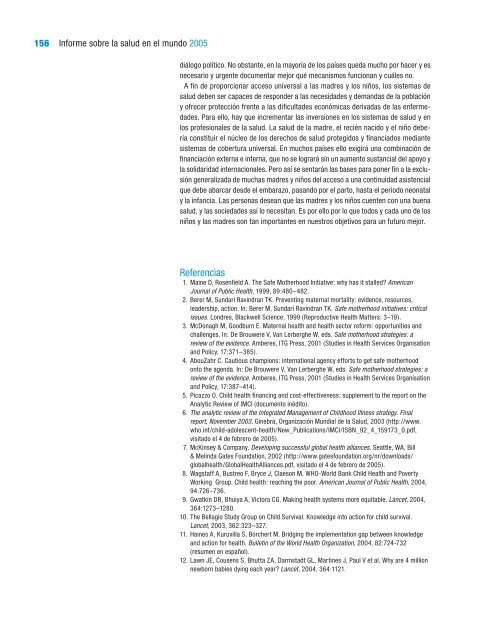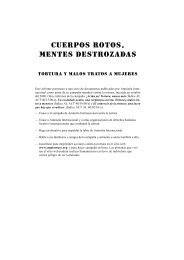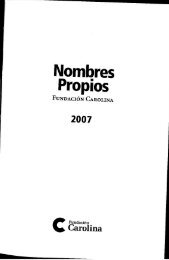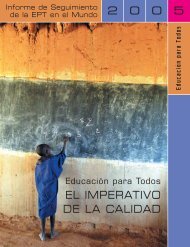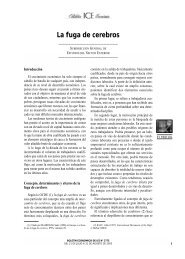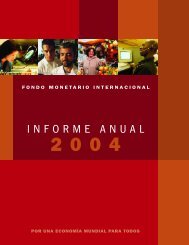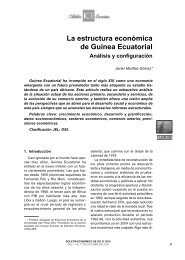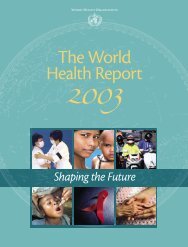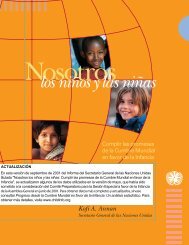conciliar <strong>la</strong> <strong>salud</strong> de <strong>la</strong> <strong>madre</strong>, <strong>el</strong> recién nacido y <strong>el</strong> niño con <strong>el</strong> desarrollo de los sistemas de <strong>salud</strong>155tura universal y completa, tarde o temprano deberán acometer, inevitablem<strong>en</strong>te, <strong>la</strong>fusión de los sistemas de protección financiera. Pocos países han logrado fusionarsin dificultades mecanismos de protección financiera fragm<strong>en</strong>tados que estaban bi<strong>en</strong>desarrol<strong>la</strong>dos, debido a que los intereses creados se impon<strong>en</strong> con frecu<strong>en</strong>cia a <strong>la</strong>srazones administrativas. Para reducir al mínimo <strong>la</strong>s dificultades, es conv<strong>en</strong>i<strong>en</strong>te g<strong>en</strong>erar<strong>en</strong> una etapa muy temprana capacidad institucional de gestión de los sistemasde protección económica, con un control firme por los gobiernos, pero con sistemasincorporados de control y equilibrio de los poderes.A fin de <strong>en</strong>marcar los servicios de <strong>salud</strong> de <strong>la</strong> <strong>madre</strong>, <strong>el</strong> recién nacido y <strong>el</strong> niño <strong>en</strong> lossistemas de acceso universal y protección financiera, se necesitarán tal vez <strong>el</strong> apoyode amplios sectores y <strong>la</strong> promesa de visibilidad política requeridos para movilizar a <strong>la</strong>sautoridades. El inconv<strong>en</strong>i<strong>en</strong>te es que no se garantiza automáticam<strong>en</strong>te <strong>la</strong> c<strong>en</strong>tralidadde <strong>la</strong> <strong>salud</strong> de <strong>la</strong> <strong>madre</strong>, <strong>el</strong> recién nacido y <strong>el</strong> niño. La mancomunación de fondos pormedio de sistemas de seguros que respald<strong>en</strong> <strong>el</strong> avance hacia <strong>el</strong> acceso universal y <strong>la</strong>protección financiera debe ir acompañada de una formu<strong>la</strong>ción c<strong>la</strong>ra de los derechos de<strong>la</strong> pob<strong>la</strong>ción a los servicios de at<strong>en</strong>ción de <strong>salud</strong> de <strong>la</strong> <strong>madre</strong>, <strong>el</strong> recién nacido y <strong>el</strong> niño.La comunidad internacional puede contribuir a ese objetivo, pero <strong>la</strong> presión deberáproceder <strong>en</strong> último término de <strong>la</strong> sociedad civil de cada país. Para <strong>el</strong>lo se necesitainiciativa política y capacidad institucional, pero también que <strong>la</strong> sociedad civil t<strong>en</strong>ga unlugar <strong>en</strong> <strong>la</strong> mesa de negociación. Al pasar <strong>la</strong> comunidad de donantes de <strong>la</strong> financiaciónde proyectos a <strong>la</strong>s estrategias de reducción de <strong>la</strong> pobreza, apoyo presupuestario g<strong>en</strong>eraly reforma d<strong>el</strong> sector, se corre <strong>el</strong> p<strong>el</strong>igro de marginar a esas organizaciones de <strong>la</strong>sociedad civil. No obstante, dichas organizaciones pued<strong>en</strong> y deb<strong>en</strong> hacer algo más queproporcionar servicios (93): son es<strong>en</strong>ciales para garantizar un compromiso políticocontinuado con <strong>la</strong> mejora de <strong>la</strong> <strong>salud</strong> de <strong>la</strong> <strong>madre</strong>, <strong>el</strong> recién nacido y <strong>el</strong> niño.Es importante que los interesados de <strong>la</strong> sociedad civil estén repres<strong>en</strong>tados <strong>en</strong> losmecanismos de gestión de <strong>la</strong> protección financiera, y <strong>en</strong> particu<strong>la</strong>r <strong>en</strong> los procesos defijación de prioridades. El objetivo es ve<strong>la</strong>r por que no se olvide <strong>la</strong> <strong>salud</strong> de <strong>la</strong> <strong>madre</strong>,<strong>el</strong> recién nacido y <strong>el</strong> niño, incluidos los numerosos aspectos políticam<strong>en</strong>te s<strong>en</strong>siblesy m<strong>en</strong>os popu<strong>la</strong>res (abortos practicados <strong>en</strong> condiciones de riesgo, embarazos deadolesc<strong>en</strong>tes, coacción y viol<strong>en</strong>cia sexuales, malos tratos y desat<strong>en</strong>ción de los niños,<strong>en</strong>tre otros). De este modo, además, aum<strong>en</strong>tan <strong>la</strong>s posibilidades de vincu<strong>la</strong>r <strong>la</strong>s políticasd<strong>el</strong> sector de <strong>la</strong> <strong>salud</strong> con <strong>la</strong>s estrategias que combat<strong>en</strong> los factores socialesdeterminantes de <strong>la</strong>s desigualdades por razón de sexo, <strong>la</strong> pobreza y <strong>la</strong> exclusión.Asimismo, es importante que los interesados de <strong>la</strong> sociedad civil interv<strong>en</strong>gan <strong>en</strong>un sistema de control y equilibrio de los poderes <strong>en</strong> lo re<strong>la</strong>tivo al funcionami<strong>en</strong>to d<strong>el</strong>os servicios de <strong>salud</strong>, tanto públicos como privados. Su función es importante paraayudar a hacer efectivos los derechos de <strong>la</strong>s <strong>madre</strong>s y los niños y para proteger a losconsumidores de <strong>la</strong> explotación económica y <strong>la</strong> <strong>sobre</strong>medicalización. Esta función devigi<strong>la</strong>ncia exige <strong>la</strong> participación no sólo <strong>en</strong> <strong>la</strong> p<strong>la</strong>nificación, sino también <strong>en</strong> <strong>la</strong> evaluacióny <strong>el</strong> seguimi<strong>en</strong>to de proyectos, programas y servicios.En muchos países, <strong>la</strong>s organizaciones de <strong>la</strong> sociedad civil ti<strong>en</strong><strong>en</strong> escasa capacidadinstitucional para apoyar <strong>la</strong> fijación de prioridades, <strong>el</strong> seguimi<strong>en</strong>to y <strong>la</strong> ayuda prestadaa <strong>madre</strong>s y niños para hacer efectivos sus derechos. En estos casos es necesariopor tanto invertir <strong>en</strong> <strong>la</strong>s organizaciones nacionales de ese tipo, <strong>en</strong> parte mediante <strong>la</strong>asignación de fondos de los donantes para esos fines (véase <strong>el</strong> recuadro 7.6). Algunospaíses lo han hecho por medio de fondos sociales y mecanismos simi<strong>la</strong>res, y otros haninstitucionalizado <strong>la</strong> co<strong>la</strong>boración con organizaciones no lucrativas y su contrataciónpara <strong>la</strong> prestación de servicios, ampliando dicha co<strong>la</strong>boración de forma natural al
156<strong>Informe</strong> <strong>sobre</strong> <strong>la</strong> <strong>salud</strong> <strong>en</strong> <strong>el</strong> <strong>mundo</strong> <strong>2005</strong>diálogo político. No obstante, <strong>en</strong> <strong>la</strong> mayoría de los países queda mucho por hacer y esnecesario y urg<strong>en</strong>te docum<strong>en</strong>tar mejor qué mecanismos funcionan y cuáles no.A fin de proporcionar acceso universal a <strong>la</strong>s <strong>madre</strong>s y los niños, los sistemas de<strong>salud</strong> deb<strong>en</strong> ser capaces de responder a <strong>la</strong>s necesidades y demandas de <strong>la</strong> pob<strong>la</strong>cióny ofrecer protección fr<strong>en</strong>te a <strong>la</strong>s dificultades económicas derivadas de <strong>la</strong>s <strong>en</strong>fermedades.Para <strong>el</strong>lo, hay que increm<strong>en</strong>tar <strong>la</strong>s inversiones <strong>en</strong> los sistemas de <strong>salud</strong> y <strong>en</strong>los profesionales de <strong>la</strong> <strong>salud</strong>. La <strong>salud</strong> de <strong>la</strong> <strong>madre</strong>, <strong>el</strong> recién nacido y <strong>el</strong> niño deberíaconstituir <strong>el</strong> núcleo de los derechos de <strong>salud</strong> protegidos y financiados mediantesistemas de cobertura universal. En muchos países <strong>el</strong>lo exigirá una combinación definanciación externa e interna, que no se logrará sin un aum<strong>en</strong>to sustancial d<strong>el</strong> apoyo y<strong>la</strong> solidaridad internacionales. Pero así se s<strong>en</strong>tarán <strong>la</strong>s bases para poner fin a <strong>la</strong> exclusióng<strong>en</strong>eralizada de muchas <strong>madre</strong>s y niños d<strong>el</strong> acceso a una continuidad asist<strong>en</strong>cialque debe abarcar desde <strong>el</strong> embarazo, pasando por <strong>el</strong> parto, hasta <strong>el</strong> periodo neonataly <strong>la</strong> infancia. Las personas desean que <strong>la</strong>s <strong>madre</strong>s y los niños cu<strong>en</strong>t<strong>en</strong> con una bu<strong>en</strong>a<strong>salud</strong>, y <strong>la</strong>s sociedades así lo necesitan. Es por <strong>el</strong>lo por lo que todos y cada uno de losniños y <strong>la</strong>s <strong>madre</strong>s son tan importantes <strong>en</strong> nuestros objetivos para un futuro mejor.Refer<strong>en</strong>cias1. Maine D, Ros<strong>en</strong>fi<strong>el</strong>d A. The Safe Motherhood Initiative: why has it stalled? AmericanJournal of Public Health, 1999, 89:480–482.2. Berer M, Sundari Ravindran TK. Prev<strong>en</strong>ting maternal mortality: evid<strong>en</strong>ce, resources,leadership, action. In: Berer M, Sundari Ravindran TK. Safe motherhood initiatives: criticalissues. Londres, B<strong>la</strong>ckw<strong>el</strong>l Sci<strong>en</strong>ce, 1999 (Reproductive Health Matters: 3–19).3. McDonagh M, Goodburn E. Maternal health and health sector reform: opportunities andchall<strong>en</strong>ges. In: De Brouwere V, Van Lerberghe W, eds. Safe motherhood strategies: areview of the evid<strong>en</strong>ce. Amberes, ITG Press, 2001 (Studies in Health Services Organisationand Policy, 17:371−385).4. AbouZahr C. Cautious champions: international ag<strong>en</strong>cy efforts to get safe motherhoodonto the ag<strong>en</strong>da. In: De Brouwere V, Van Lerberghe W, eds. Safe motherhood strategies: areview of the evid<strong>en</strong>ce. Amberes, ITG Press, 2001 (Studies in Health Services Organisationand Policy, 17:387–414).5. Picazzo O. Child health financing and cost-effectiv<strong>en</strong>ess: supplem<strong>en</strong>t to the report on theAnalytic Review of IMCI (docum<strong>en</strong>to inédito).6. The analytic review of the Integrated Managem<strong>en</strong>t of Childhood Illness strategy. Finalreport, November 2003. Ginebra, Organización Mundial de <strong>la</strong> Salud, 2003 (http://www.who.int/child-adolesc<strong>en</strong>t-health/New_Publications/IMCI/ISBN_92_4_159173_0.pdf,visitado <strong>el</strong> 4 de febrero de <strong>2005</strong>).7. McKinsey & Company. Dev<strong>el</strong>oping successful global health alliances. Seattle, WA, Bill& M<strong>el</strong>inda Gates Foundation, 2002 (http://www.gatesfoundation.org/nr/downloads/globalhealth/GlobalHealthAlliances.pdf, visitado <strong>el</strong> 4 de febrero de <strong>2005</strong>).8. Wagstaff A, Bustreo F, Bryce J, C<strong>la</strong>eson M, WHO-World Bank Child Health and PovertyWorking Group. Child health: reaching the poor. American Journal of Public Health, 2004,94:726–736.9. Gwatkin DR, Bhuiya A, Victora CG. Making health systems more equitable. Lancet, 2004,364:1273–1280.10. The B<strong>el</strong><strong>la</strong>gio Study Group on Child Survival. Knowledge into action for child survival.Lancet, 2003, 362:323–327.11. Haines A, Kuruvil<strong>la</strong> S, Borchert M. Bridging the implem<strong>en</strong>tation gap betwe<strong>en</strong> knowledgeand action for health. Bulletin of the World Health Organization, 2004, 82:724-732(resum<strong>en</strong> <strong>en</strong> español).12. Lawn JE, Cous<strong>en</strong>s S, Bhutta ZA, Darmstadt GL, Martines J, Paul V et al. Why are 4 millionnewborn babies dying each year? Lancet, 2004, 364:1121.


